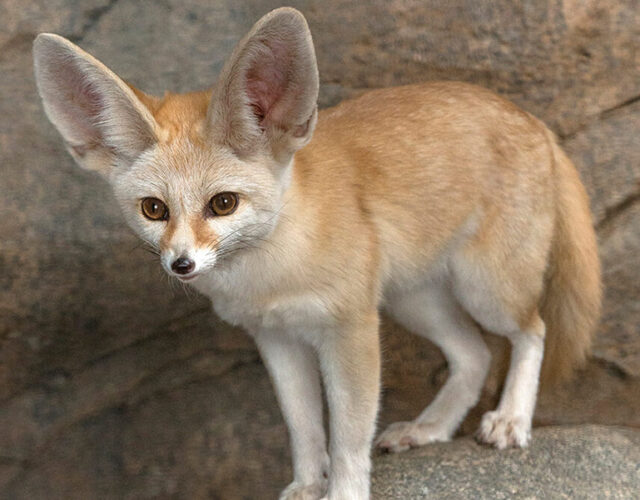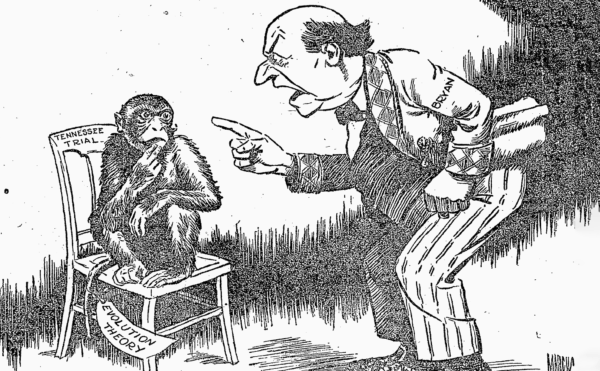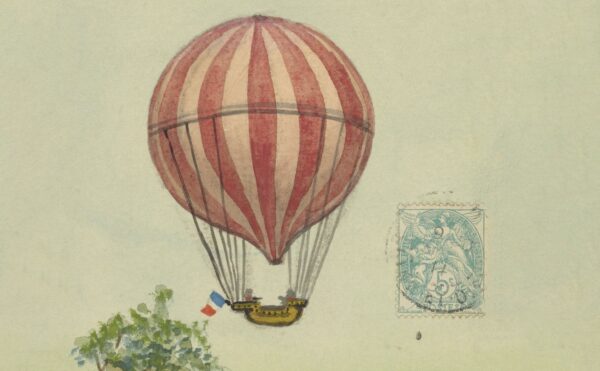On this episode of The Disappearing Spoon, Sam Kean delves deep into the science behind the evolution of animal and human bodies. Like animals, human bodies have also evolved to adhere to the demands of ever-changing climates. This raises a question: how will human bodies respond to climate change?
Credits
Host: Sam Kean
Senior Producer: Mariel Carr
Producer: Rigoberto Hernandez
Audio Engineer: Jonathan Pfeffer
Photo: Alchetron
Transcript
Imagine going to a museum and seeing a display on ancient human ancestors. These ancestors looked a lot like us, of course, but just a little different. Their jaws were bigger and bulkier. They had sloping foreheads and snub noses. They were shorter and shaggier and hunched over, not quite comfortable yet on two feet.
Now imagine going to a museum in the remote future. And imagine that the ancestors on display then are, well, us. You and me. What traits about us would stand out to those future humans?
That depends, of course, on how human beings evolve and change in the future. And while that’s impossible to predict completely, scientists do know of certain factors that drive animal evolution.
One big one is climate. That is, when climates change, animal bodies change in predictable ways. Depending on the details, the animals might get bigger or smaller, or have their appendages change size.
And of course, Earth is now entering a period of unusually fast global warming. So in today’s episode, I’d like to try a little thought experiment.
Let’s say we hit pause on modern technology. That is, let’s put aside the possibility that humans in the future might actively engineer our DNA. Let’s also say that climate change continues, and that Earth grows much warmer. How would that new climate remake the human body?
As we’ll see, some of the predictions in play are controversial. But they’re nevertheless thought-provoking. Modern human beings are roughly a quarter-million years old. And the next quarter-million years of evolution could be every bit as interesting.
Most of the so-called biological “rules” that I’ll be talking about are pretty old and hoary. Some predate Charles Darwin and his theories of evolution. They’re mostly named after obscure nineteenth-century biologists that nobody’s ever heard of. Especially in an age of genetics and molecular biology, these rules might seem like dusty antiques.
Still, scientists have told me that, if you do dust the rules off, they can be surprisingly powerful tools for making predictions about how climate change might reshape and remake animals. Sometimes there’s wisdom hidden inside old hoary history, if we only take the time to look.
Now, before we get started on these rules, I should add a word of caution. Biology doesn’t have “laws” like chemistry or physics does. There aren’t exceptions to, say, the law of gravity. Rules in biology are more loosey-goosey. Organisms and ecosystems are so complex that biology deals mostly in rules of thumb.
So with that caveat in mind, let’s start with the best-known biological rule: Bergmann’s rule, named after the otherwise forgettable German biologist Carl Bergmann.
Bergmann’s rule involves the size of animals. Let’s take bears as an example. Bergmann’s rule says that, within a group of animals, the bigger ones live closer to the poles, and the smaller ones live closer to the tropics.
With bears, that definitely holds true. Polar bears tower over the brown bears who live in mid-latitude forests. And both polar bears and brown bears dwarf tropical sun bears in Southeast Asia. The same general rule holds true for insects and birds and fish, too. Within a group of animals, the bigger species live closer to the poles.
Now, you can explain Bergmann’s rule in one of two ways. There’s a simple explanation, and there’s a not-so-simple explanation involving geometry. And if you crave those details, I’ve put together a bonus episode at Patreon.com/disappearingspoon.
There’s also a little bonus-within-the-bonus about using another one of those hoary old rules to take a census of Tyrannosaurus rex. That is, if you ever wondered how many T-rexes ever lived in Earth’s history, scientists now have an answer. And it might surprise you. That’s patreon.com/disappearingspoon.
But to stick to the straightforward explanation here, Bergmann’s rule about body size and temperature holds true because bigger bodies are better at retaining internal heat. That’s why bigger animals like polar bears live closer to the poles. Their big size keeps heat inside and prevents them from freezing to death.
Of course, if you transported polar bears to the tropics, they’d overheat and die. Sadly, this happens at zoos sometimes. On the flip side, if you dragged tropical sun bears to the North Pole, they’d turn into bear popsicles.
So what does Bergmann’s rule predict with regard to global warming? Well, if the world warms, most animals should get smaller. They’ll shrink in size.
For human beings, things are more complicated. Most people live in shelters and wear clothing nowadays. Some people also have air conditioning, which helps fight off overheating. And thanks to better nutrition, human beings have generally gotten taller over the past several thousand years.
But again, climate is a powerful force. If global warming gets really bad, that trend of taller huan beings could halt, or even reverse. The NBA centers of today could be the mythological giants of the future.
The next biological rule to examine links temperature change to the size of different organs. Take the heart.
According to what’s known as Hesse’s <“hess’s”> rule, animals in colder climates generally have larger hearts in relation to body size. That’s especially true for warm-blooded animals, like mammals and birds.
Just like with overall size, body heat is the big driver here. Warm-blooded animals need to pump blood throughout their bodies to keep warm. A larger heart pumps blood more efficiently. So having a bigger heart in relation to body size helps you survive.
But in a warming world, animals can get by with smaller hearts. So animal hearts should shrink in the future. And there’s no reason to think this won’t happen to humans. It’ll be the opposite of that scene in Dr. Seuss’s How the Grinch Stole Christmas. There, in the snowy landscape outside Whoville, the Grinch’s heart was two sizes too small. But in a warming world, his heart might be just right.
Similar to Hesse’s rule, there’s Allen’s rule, which involves the size of other body parts—especially appendages like ears and beaks.
I once went camping in the Sahara Desert in Egypt, hours away from the nearest city. And I was startled to see the desert foxes there. They have absolutely gigantic ears. They looked like rabbits. It’s almost comical.
But those big ears help them survive by dissipating excess body heat. Similar to a car’s radiator, ears with big surface areas allow them to radiate extra heat and keep cool. For that same reason, many tropical birds have big beaks to keep cool.
So humans could end up with big ears as well. Or maybe we’ll get giant noses. In fact, there’s good evidence that the human nose changed dramatically in some places long ago as people migrated into colder climates. Specifically, those noses became narrower and longer. This helps heat up cold air before it enters the lungs. If the climate warms up in the future, noses worldwide could therefore become shorter and wider again.
By this same logic, humans might also get longer limbs.
You’ve probably heard of the Neanderthals, close cousins of human beings. Neanderthals thrived in northern climates during the last Ice Age tens of thousands of years ago. And in general Neanderthals were more barrel-chested and stubbier-limbed than modern humans, who first arose in Africa.
Some humans are of course barrel-chested as well. But in a warmer world, people with that build will probably become scarcer and scarcer, because a slender torso and longer arms and help dissipate heat. It’s simply more comfortable in warmer weather.
The final rule we’ll look at is Gloger’s <GLOW-grrr> rule, which involves animal color. We’ll first examine how this rule applies animals in general. Then we’ll look at the much more controversial—and dubious—application of the rule to human beings.
Gloger’s rule is named after a Prussian fellow named Constantin Gloger, who lived in the early 1800s and sported a small bouffant hairdo and chinstrap beard.
The rule sprang from a book from he wrote in 1833, a book that one scientist described to me as very dense and terribly written. Not exactly a ringing endorsement. But there was one nugget in the book worth salvaging.
In short, Gloger’s rule claims that animals in warmer tropical regions are darker than animals in colder north regions. The reason for this was traditionally thought to depend on the type of animal involved.
With mammals, darker skin and hair protect against damaging ultraviolet rays, since UV rays are more intense in equatorial places.
With birds, protection against UV rays is good, but there’s more going on. Bird feathers that are darker have a higher concentrations of certain pigments; and those darker pigments resist bacterial infestation better than light-colored pigments. That resistance to infection is a big advantage in the petri dish of the tropics.
In contrast, in more northerly places there are fewer UV rays and fewer microbes. So dark colors don’t produce much of an advantage. In addition, some animals in the north are white-colored as camouflage against snow.
But as the world warms up, and snowmelt increases, that white color won’t help animals hide. In fact, being snowy white in a non-snowy forest would make you stand out—a disadvantage. And in fact, among owls in Finland, there’s already been a decided shift over the past half-century away from pale grey owls and toward brown-colored owls. So again, as the world warms, Gloger’s rule hints that animals will get darker.
However, Gloger’s rule remains controversial among biologists. For one thing, birds and mammals aren’t the only animals out there. What about cold-blooded reptiles, or insects?
Gloger’s rule also fails to distinguish between temperature and humidity. In general, warm places are also more humid than cold ones. So if animals are indeed darker in the tropics, how do you know whether the cause is temperature or humidity?
In fact, many biologists believe that, if you actually do control for humidity, then Gloger’s rule gets flipped on its head—that warmer climates actually lead to lighter animals.
That’s especially true for cold-blooded critters. Insects and reptiles rely on external heat sources. And in cold places, having a dark exterior helps soak up sunlight. In warmer climates, that constraint is relaxed, and animals end up lighter.
Then there’s humidity. More humidity leads to abundant plant life. And the growth of plants leads to shadows, where smaller animals can hide from predators. Animals therefore tend to be darker in wet places to camouflage themselves.
Overall, then, a place with cool, wet forests—like Tasmania—would have the darkest critters. Meanwhile, dry, warm places like deserts would have the lightest animals.
This new, revamped Gloger’s rule can help us understand future climate change, too. In places that will get cooler or more humid, animals should get darker. Meanwhile, in places that will get drier and warmer—like the Amazon—animals should get lighter.
But of course, sometimes those predictions conflict! Models for climate change suggest that the boreal forests of Siberia will get both hotter and wetter. In which case temperature and humidity predictions contradict each other. Who knows what will happen there.
So yeah, predictions about whether animals will grow darker or lighter get pretty messy. And things get even messier for human beings. Especially because skin color can be such a charged issue.
Now, we can say some things that are uncontroversial. The first human beings arose in Africa—we’re all Africans deep down. And the first human beings had dark skin. That’s because dark skin helps block ultraviolet sunlight. This helped prevent DNA damage and skin cancer in the intense equatorial sun of Africa.
Later, as people migrated out of Africa, skin color got lighter in many places, especially Europe and Asia. The reason is simple. Too much sunlight can damage skin, but too little sunlight can also harm your health. That’s because the human body needs a little UV sunlight to make vitamin D, an essential nutrient. Lighter skin let more UV sunlight through. So people with lighter skin suffered less from vitamin D deficiencies.
Now, all these factors driving skin color are of course ancient. With modern nutrition and shelters, they’re not necessarily at work today. And again, because this is a charged political issue, let me say once again that biology doesn’t have hard-and-fast laws. There are exceptions. For instance, Great Britain is a pretty chilly place. But the original inhabitants of Great Britain several thousand years ago all had quite dark skin.
But in general, Gloger’s original rule did hold for human beings in ancient times. People in warm, equatorial places tended to have darker skin, while people in colder northern places tended to have lighter skin.
So as the climate changes in the future, will Gloger’s rule lead to a big shift in human skin color?
Probably not. Remember, what drove the evolution of skin color in humans wasn’t warmth per se but the intensity of sunlight. And there won’t suddenly be more sunlight in a warmer world.
Even more importantly, human beings also interbreed widely now. We’re not confined to where our ancestors live. Humans populations are also booming in some places and stagnating in others. Plus, sexual selection plays a big role in how human beings fall in love and mate.
In other words, you can’t just blindly apply the same rules to insects and birds and human beings without taking all that stuff into account. Human skin color is a beautiful mosaic now, and probably will be in the future as well.
Laying skin color aside, then, and assuming no major technological changes, what will human beings look like in the future?
They’ll probably be no taller than today, and perhaps a bit shorter. They’ll have smaller hearts and be more willowy, with less barrel-y chests. They also might have goofy-big noses and ears. They’ll still be recognizably human. But they could fall into that uncanny valley we experience today when we look at museum displays of Neanderthals or human ancestors.
And laying aside humans, animal bodies will change, too. In some ways, it’s an intriguing time for biology. These nineteenth-century rules are hoary and old and have long been forgotten. But in the twenty-first century, they could hold the very key to understanding the future of biology.




